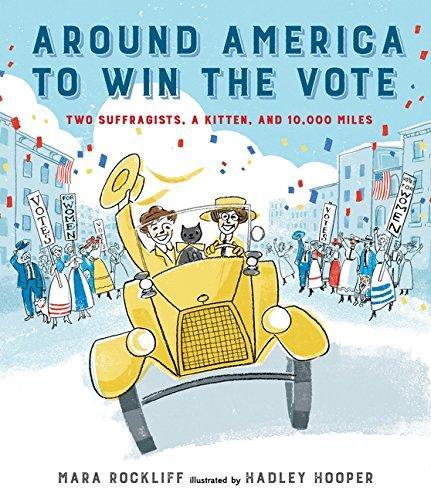
Around America to Win the Vote
Read Aloud Book: Around America to Win the Vote
Story: Mara Rockliff
Illustration: Hadley Hooper
ISBN-13: 978-0763678937
C3 Framework Key term: Historical times: Time periods of different lengths, depending upon the scale and meaning of events, and the relationships between them.
Synopsis
Nell Richardson and Alice Burke had a plan. They would drive around the country and show all citizens that women can be both productive and intellectual, and both peace-loving and brave. If they see all these qualities in women, they would grant them voting rights. Nell and Alice (and their cat) drove in harsh weather conditions and on poor roads, in a car that was made in the very early days of the car industry. They did not give up until they circled the nation and returned safely to New York.
Discussion
Contextualize: The women’s suffrage movement in the US began in the 1840s and continued through the 1920s. It ended with the ratification of the 19th Amendment granting women the right to vote. It led to increased representation of women in the Congress. In 1922, one woman (for a short period of time) and 99 men comprised the US Senate. But women representation has increased over the years. In 2017, 105 (78 democrats, 27 republicans) women hold seats in the United States Congress, comprising 19.6% of the 535 members; 21 women (21%) serve in the United States Senate, and 84 women (19.3%) serve in the United States House of Representatives. Ask: What made Nell Richardson and Alice Burke take this long and dangerous road trip? Write on the board “E Pluribus Unum.” Explain: This phrase, Latin for "out of many, one," is part of the Great Seal of the United States, that means: out of many states, one country. An additional meaning, is the representation of ALL American people under one government. Ask: Would granting women the right to vote make this phrase truer? Conclude with the moral argument raised by President Woodrow in his September 30, 1918 speech to the Senate.
Ethics Connection
Say: In your table groups, pretend you are back in the early 1920s and debating women’s right to vote. Listen respectfully to others’ opinions and do not talk out of turn. The purpose of this debate if to gain an understanding why it took so many years to grant women the right to vote. Provide students with examples of both sides of the debate. Say: Anti-suffragists arguments included: 1. Because women did not serve on jury duty or in the armed forces, they should not make the laws these institutions enforce. 2. Because many women did not join the movement, women did not really want to vote. 3. Women’s vote are redundant. Women can express their opinions through their fathers, brothers, husbands, and sons. Their job is to nurture others, so others can represent them. Suffragists arguments included: 1. All those who obey the law should participate in law making. 2. There are laws that discriminate against women and women representatives can help amend them. 3. If women can influence public policy they will be treated with greater respect and equality.
Fun Activity
Say: Imagine you are a reporter assigned by your editor to write a front page article about the ratification of the 19th amendment on August 26, 1920. Use the Congress resolution document to write a 200-word piece. You can review real examples, such as the New York Time’s article, “Colby Proclaims Woman Suffrage,” to consider the writing style for your article.